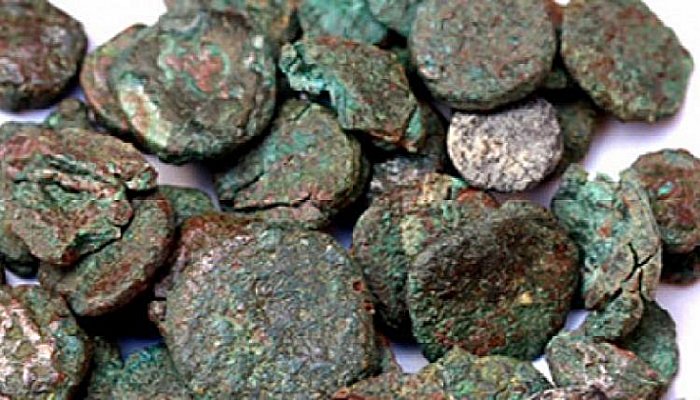Conny Waters – AncientPages.com – Thousands of previously ignored small coins discovered in Marea, a city near Alexandria, have been examined by numismatists from the Faculty of Archaeology of the University of Warsaw.

Studies of coins from Marea. The contents of one of the pouches. Credit: Piotr Jaworski, University of Warsaw
The pharaoh Psamtik I installed a garrison at Marea in 654 BCE to secure the western borders of his kingdom after he had previously defeated the Libyan tribes living in the area who had taken over the Oxyrhynchite nome of Lower Egypt.
Their findings change the previous image of monetary circulation in Egypt at the end of antiquity. The University of Warsaw reports on the research project in a release on the university’s website.
Marea (known as Philoxenite in the Byzantine period), located on the southern shore of Lake Mareotis, was founded on the site of an older settlement at the end of the 5th century CE. The pharaoh Psamtik I – the first pharaoh of the Twenty-sixth Dynasty of Egypt, the Saite period, ruling from the city of Sais in the Nile delta between 664–610 BC – installed a garrison at Marea in 654 BCE.
Psamtik I wanted to secure the western borders of his kingdom. It happened after he had previously defeated the Libyan tribes living in the area who had taken over the Oxyrhynchite nome of Lower Egypt. During the times of Emperor Justinian, it acquired an impressive architectural setting and infrastructure, becoming an important stopping place for pilgrims heading to the grave of Saint Menas, one of the most famous martyrs of early Christianity, in the Egyptian desert.
The Polish Centre of Mediterranean Archaeology UW has been conducting archaeological research in Marea – once a large port city in the Roman period, and possibly already in the Ptolemaic times – since 2000. The current work is supervised by Professor Tomasz Derda.
As part of a long-running research project financed by the Polish National Science Centre, a team of numismatists from the Faculty of Archaeology of the University of Warsaw, led by Dr. Piotr Jaworski, examined nearly 8,500 Byzantine and Umayyad coins. Among them, they discovered several treasures, such as the remains of pouches and thousands of coins lost by the city’s inhabitants and pilgrims who stayed in the city before the last stage of the pilgrim trail to Abu Mena.
‘The importance of the research we conduct in Marea cannot be overestimated, because the material culture of this rich Byzantine city gives an idea about the most important city in the region – Alexandria. Due to the rapid development of the city in the 19th and 20th centuries, the possibilities of conducting archaeological research there are extremely limited, and the state of research on monetary finds is far from satisfactory,’ says Dr. Jaworski.
The results of numismatic research conducted in Marea are surprising because they paint a picture of monetary circulation in Egypt at the end of antiquity that differs from that known from literature.
Most existing publications focus on the coinage of Byzantine Alexandria. An important exception and basic reference material for Polish numismatists is the body of finds from nearby Abu Mena, compiled by Hans-Christoph Noeske.
Research findings show that before the Umayyad caliphs took power, Egypt seemed to be part of an economic zone extending far beyond the territory of the country and covering large areas of the eastern Mediterranean, and the closest similarity of the monetary circulation model can be found in today’s Israel.
According to the University of Warsaw press release, these important findings were possible primarily due to focusing on the most numerous (approximately 75 percent of the total number of finds), although seemingly least attractive group of coins: those with a diameter of only a few millimetres, called nummi minimi.
The vast majority of nummi minimi were stored in pouches, numerous remains of which were discovered at the research site. These coins have so far been mostly marginalized in scientific publications.
Meanwhile, numismatists from the University of Warsaw decided to look at each of them, even the smallest and poorly preserved one. Thanks to this, they discovered that the group of nummi minimi found in Marea was dominated by coins minted in Carthage by the Vandal kings and then, after retaking Africa from the barbarians, by Justinian.
See also: More Archaeology News
The researchers also identified Ostrogothic small coins, which – like Vandal coins – began to flow widely into the eastern Mediterranean after the Ostrogothic kingdom was ended by Justinian.
Researchers say that among the coins found in Marea, many of them are local Egyptian imitations. They include coins inspired by the coinage of the Kingdom of Aksum and imitations of Byzantine coins minted in Alexandria. A surprisingly large group are blanks, i.e. empty mint discs made of copper or lead, serving as subsтιтute coins.
Original story – Science in Poland
Written by Conny Waters – AncientPages.com Staff Writer





